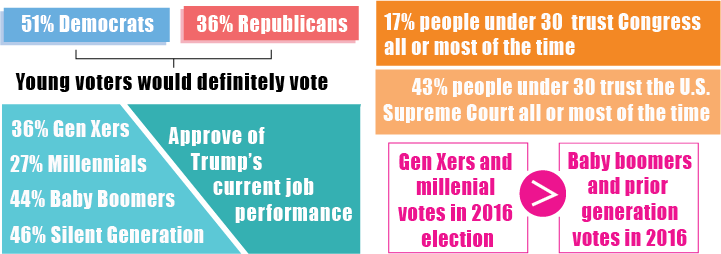Poll shows more young people planning to vote than ever
In a recent national poll by the Harvard Institute of Politics (IOP), more young voters reported that they will definitely be voting in this year’s elections than in the past two midterm years.
Among those surveyed, 51 percent of Democrats said they would definitely vote, while 36 percent of Republicans said the same.
These numbers illustrate a dramatic shift from the 2014 midterm elections, where young Republicans tended to be more enthusiastic about voting, according to The Harvard Crimson, Harvard University’s student newspaper.
The Crimson attributes this rise in young voters to President Trump’s falling approval ratings among millennials and Gen Xers. In addition, recent political movements such as #MeToo and student activism following the Parkland school shooting have allowed young Democrats to feel like they are able to speak up.
The Crimson also reported that, as of last semester, 25 percent of students surveyed during the fall semester approved of the Trump administration, while 72 percent disapproved.
Young people express high rates of distrust in other major institutions, according to The Crimson. Only 17 percent of people under 30 said that they trust Congress all or most of the time, while 43 percent say the same about the U.S. Supreme Court.
Social media trust rates have fallen as well. As a result of the Facebook data breach, around 25 percent say they distrust Facebook all or most of the time.
College and university administrations, however, have managed to maintain high rates of trust, with 61 percent of young people saying they trust them all or most of the time.
Nationally, 27 percent of millennials and 36 percent of Gen Xers approve of Trump’s job performance, according to a recent Pew Research Center survey. In contrast, 44 percent of baby boomers and 46 percent of the silent generation approve.
Pew Research Center defines the “silent” generation as anyone born from 1925-1945, the baby boomers as anyone from 1946-1964, Generation X as anyone from 1965-1980, and millennials (“Generation Y”) as anyone born from 1981-1996. All people born from 1997 on are known as “Generation Z.”

People 60 and older dominate the electorate in every election for both midterm and presidential election years since 1992, and have tended to vote more heavily Republican.
On the other hand, young people as a demographic tend to lean more heavily Democratic, according to Pew statistics. If turnout among young voters, specifically millennials, is high this year, it is possible that the Republican party could suffer some serious losses in Congress.
The actual outcome of the election depends on who shows up to the polls, not who says they will. In the past, millennials and Gen Xers were notoriously bad at turning up to vote: people in these generations were commonly labeled as “low propensity” voters because their age group voted at a lower rate than any other generational group, according to a report by PolitiFact.
The political turning point? The 2016 presidential election.
A Pew survey from 2017 revealed that Gen Xers and millennials actually outvoted baby boomers and prior generations combined in 2016. Out of the two, however, Gen Xers cast more votes, making 2016 their current peak year.
Pew states that the difference between the generations is likely to narrow as time goes on because, as generations age, their voter turnout rates generally becomes more closely matched to that of the previous generation.
In Pennsylvania, the deadline for voter registration passed on April 16. Anyone who has recently turned 18 and has not yet registered to vote must wait until the next election cycle, the 2020 presidential elections, to vote.
An IOP poll focusing on the attitudes of young people toward the overall state of U.S. politics is due to be released later this week. The upcoming poll will help to further define the political landscape of this demographic.













































